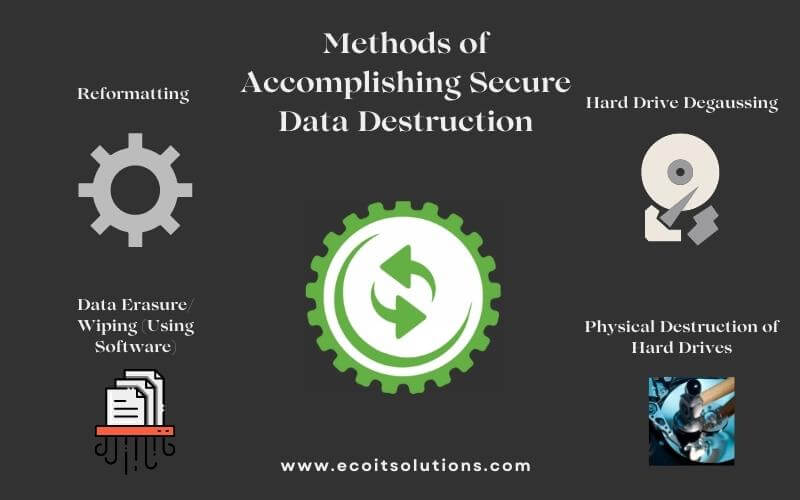The Effect of Effective Data Destruction on Cyber Security Risk Administration
The Effect of Effective Data Destruction on Cyber Security Risk Administration
Blog Article
The Significance of Effective Data Damage Practices in Safeguarding Sensitive Details and Ensuring Computer System Security
In an era where data violations are significantly usual, the value of efficient data devastation methods can not be overemphasized. Organizations face considerable dangers when delicate information is improperly dealt with, potentially resulting in unapproved accessibility and serious economic repercussions. Executing robust information damage methods not only alleviates these dangers but also aligns with legal conformity demands, ensuring that companies copyright their credibility and foster customer trust. The question continues to be: what specific techniques can be used to enhance these techniques, and how can organizations effectively integrate them into their total cybersecurity structure?
Recognizing Information Destruction
Recognizing information destruction is essential in today's electronic landscape, where sensitive information can conveniently be endangered. Reliable data destruction includes not merely making sure but removing files that information is irretrievable via detailed approaches. This procedure is crucial for companies that manage private customer information, intellectual home, or inner documents, as any kind of violation can result in serious monetary and reputational effects.
Data destruction encompasses different techniques, consisting of shredding physical media, degaussing magnetic storage space devices, and employing software-based solutions that overwrite information multiple times. Each technique offers a specific objective and has to align with the level of sensitivity of the info being gotten rid of. For instance, physical destruction is frequently favored for hard drives consisting of highly private data, while software program methods could be adequate for less sensitive information.
Additionally, sticking to market requirements and laws, such as the General Information Security Law (GDPR) or the Medical Insurance Transportability and Accountability Act (HIPAA), is necessary for conformity and to alleviate lawful risks. Organizations needs to create a robust information damage policy, train staff members on finest techniques, and routinely audit their procedures to make sure that all delicate information is gotten rid of firmly and efficiently.
Dangers of Inadequate Practices
Inadequate information damage techniques expose companies to significant risks that can have far-ranging repercussions. When sensitive info is not correctly disposed of, it remains at risk to unapproved gain access to, which can result in information breaches and identity burglary. Such incidents not just compromise the safety of people yet additionally tarnish the organization's online reputation, leading to a loss of consumer depend on and prospective monetary repercussions.
Moreover, regulatory compliance is progressively strict in many markets. Failure to follow data devastation policies can result in significant fines and lawsuits against companies. These fines can divert and strain monetary sources attention from core service procedures.
Furthermore, the misuse of recurring information can lead to intellectual home theft or corporate espionage, jeopardizing affordable benefits (data destruction). The influence of inadequate information destruction expands past immediate economic losses; it can additionally lead to long-term damages to brand name integrity and market position

Organizations need to recognize that data safety and security is not only concerning stopping violations; it also encompasses the liable management of information throughout its lifecycle. Overlooking efficient information destruction procedures can have devastating ramifications, highlighting the need for durable procedures to alleviate these risks.
Ideal Practices for Information Damage
Carrying out reliable data damage methods is necessary for protecting delicate info and keeping compliance with regulative standards. Organizations must adopt a multi-faceted technique to make certain that data is irretrievable, consequently avoiding unapproved accessibility and prospective breaches.
First, information need to be categorized based on level of sensitivity, enabling companies to use ideal damage techniques customized to the level of risk. For digital information, using software-based data-wiping devices that abide by industry criteria can successfully overwrite existing data. Physical devastation methods, such as shredding or degaussing, are essential for gadgets that save sensitive information, making certain full elimination.
Establishing a clear data retention policy is important, detailing the length of time different kinds of details need to be kept prior to damage. Routine audits of information storage space systems are also required to recognize out-of-date or unnecessary data needing elimination.
Furthermore, training staff members on the significance of data destruction and the specific methods to comply with fosters a society of safety and security within the organization. Ultimately, maintaining documentation of information destruction refines gives liability and sustains compliance with inner policies and outside guidelines. By adhering to these ideal practices, organizations can significantly alleviate the risks related to data direct exposure.
Legal and Conformity Factors To Consider

Failure to adhere to these laws can result in severe fines, including substantial penalties and reputational damages. Organizations must implement a robust data destruction plan that aligns with these legal structures and offers clear guidelines on the proper methods of data disposal, whether my review here physical shredding or digital wiping.
Additionally, keeping documents of information destruction activities is crucial for demonstrating conformity throughout audits or assessments. By focusing on legal and compliance factors to consider, companies can boost their information security position and foster depend on with customers and stakeholders, ultimately contributing to a much more safe and secure information monitoring environment.
Benefits of Effective Information Damage
Effective data damage methods prolong past mere compliance; they use considerable advantages to organizations that prioritize them. By making sure that sensitive info is irretrievably damaged, companies minimize the danger of data breaches and the prospective monetary repercussions connected with them. This positive approach not just safeguards versus unauthorized accessibility but also enhances the total trustworthiness of the organization in the eyes of stakeholders and customers.
Executing robust data damage techniques, such as physical devastation of storage space devices or advanced information cleaning techniques, adds to the conditioning of an organization's cybersecurity pose. data destruction. It lowers the possibility of intellectual building burglary and safeguards proprietary info, therefore preserving an affordable edge in the marketplace

Conclusion
In conclusion, reliable information damage practices are vital for guarding sensitive info and enhancing total computer safety and security. Eventually, a commitment to durable data destruction methods fosters a culture of obligation, thereby enhancing a company's cybersecurity stance and preserving customer trust fund.

Report this page